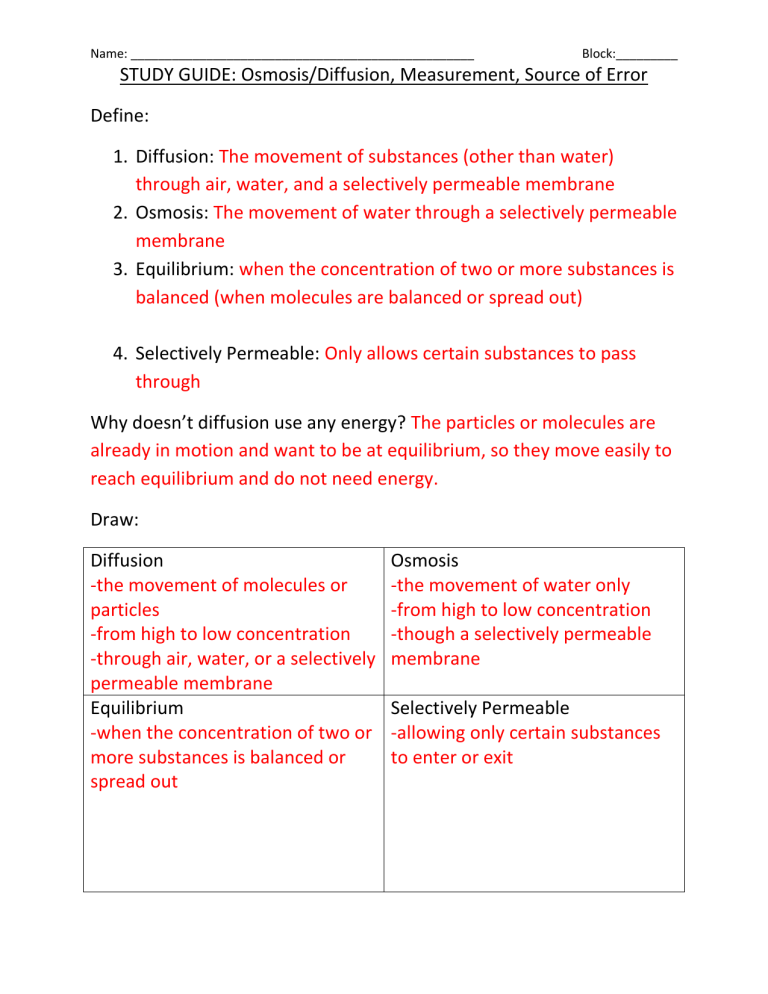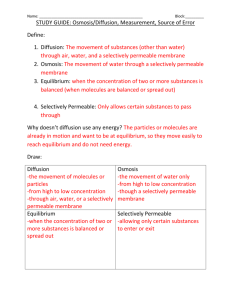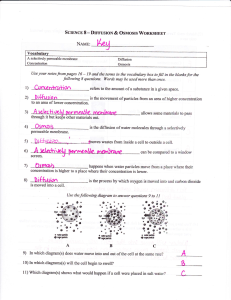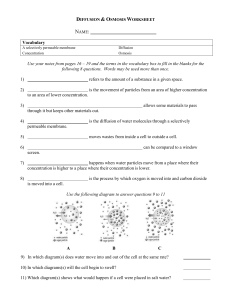
Name: __________________________________________________ Block:_________ STUDY GUIDE: Osmosis/Diffusion, Measurement, Source of Error Define: 1. Diffusion: The movement of substances (other than water) through air, water, and a selectively permeable membrane 2. Osmosis: The movement of water through a selectively permeable membrane 3. Equilibrium: when the concentration of two or more substances is balanced (when molecules are balanced or spread out) 4. Selectively Permeable: Only allows certain substances to pass through Why doesn’t diffusion use any energy? The particles or molecules are already in motion and want to be at equilibrium, so they move easily to reach equilibrium and do not need energy. Draw: Diffusion -the movement of molecules or particles -from high to low concentration -through air, water, or a selectively permeable membrane Equilibrium -when the concentration of two or more substances is balanced or spread out Osmosis -the movement of water only -from high to low concentration -though a selectively permeable membrane Selectively Permeable -allowing only certain substances to enter or exit Name: __________________________________________________ Block:_________ Compare and Contrast Osmosis and Diffusion The movement of water only Through a selevtively permeable membrane -The movement of molecules other than water No energy required -through air and water Draw what the following solutions look like at equilibrium: Given At Equilibrium Already in equilibrium Given At Equilibrium Name: __________________________________________________ Block:_________ Source of Error Define source of error: ___Experimental errors cause doubt about the accuracy of your data. Experimental errors are not under the control of the experimenter. Human mistakes are caused by the experimenter.___ Scenario A thunderstorm occurs while Matt and Allison are measuring evaporation rates of a liquid. Lyndria is testing the time it takes a ball to drop from different heights. There is wind resistance during each trial. Felecia is investigating whether Bounty or Brawn Paper Towels absorb water faster. While she is conducting her experiment, Tabitha spills water on her table. Human Mistake or What do you do? Experimental Error Experimental Error Include the problem in your experimental report Experimental Error Include the problem in your experimental report Human mistake Complete the experiment again Answer the Questions: 1. At 0 ⁰C, water is: (circle one) SOLID/LIQUID/GAS. 2. At 37 ⁰C, water is: (circle one) SOLID/LIQUID/GAS. 3. At 105 ⁰C, water is: (circle one) SOLID/LIQUID/GAS. Name: __________________________________________________ Block:_________ Measurement Answer the Questions: -3 °C 4. At 0 ⁰C, water is: (circle one) SOLID/LIQUID/GAS. 5. At 37 ⁰C, water is: (circle one) SOLID/LIQUID/GAS. 6. At 105 ⁰C, water is: (circle one) SOLID/LIQUID/GAS. 2 g/ml Complete the Table: 2 g/ml 3.1 cm Definition Tool(s) Units Length Distance Ruler or Meter Stick centimeter (cm) millimeter (mm) Mass The amount of matter in an object triple beam balance grams (g) Volume Amount of space an object takes up For irregular-use displacement methods For regular solids-use L x W x H Graduated Liter (L) or cubic Cylinder or Ruler centimeter (cm3) Temperature The amount of heat in an object thermometer degrees Celcius (°C) or Kelvin (K) Density Amount of molecules in a certain space Mass ÷ Volume grams/liter (g/cm3) (M/V)





